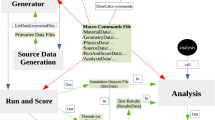Abstract
In order to construct a library of Iranian pediatric voxel phantoms for radiological protection and dosimetry applications, an Iranian eight-year-old phantom was constructed from a series of CT images. Organ and effective dose conversion coefficients to this phantom were calculated for head, chest, abdominopelvis and chest–abdomen–pelvis scans at tube voltages of 80, 100 and 120 kVp. To validate the results, the organ and effective dose conversion coefficients obtained were compared with those of the University of Florida eight-year-old voxel female phantom as a function of examination type and anatomical scan area. For a detailed study, depth distributions of organs together with the thickness of surrounding tissues located in the beam path, which are shielding the internal organs, were determined for these two voxel phantoms. The relation between the anatomical differences and the level of delivered dose was investigated and the discrepancies among the results justified.






Similar content being viewed by others
References
Akhlaghi P, Hakimabad HM, Motavalli LR (2014a) An overview of exposure parameters, dose measurements and strategies for dose reduction in pediatric CT examinations. Radioprotection 49:9–15
Akhlaghi P, Hakimabad HM, Motavalli LR (2014b) Effects of shielding the radiosensitive superficial organs of ORNL pediatric phantoms on dose reduction in CT examinations. J Med Phys 39:238–246
Akhlaghi P, Hakimabad HM, Motavalli LR (2015a) Dose estimation in reference and non-reference pediatric patients undergoing computed tomography examinations: a Monte Carlo study. Radioprotection 50:43–54
Akhlaghi P, Hakimabad H, Motavalli LR (2015b) Dose estimations for Iranian 11-year-old pediatric phantoms undergoing computed tomography examinations. J Radiat Res. doi:10.1093/jrr/rrv017
Berrington de Gonzalez A, Mahesh M, Kim KP, Bhargavan M, Lewis R, Mettler F, Land C (2009) Projected cancer risks from computed tomographic scans performed in the United States in 2007. Arch Intern Med 169:2071–2077
Brenner DJ, Hall EJ (2007) Computed tomography—an increasing source of radiation exposure. N Engl J Med 357:2277–2284
Caon M, Bibbo G, Pattison J (1999) An EGS4-ready tomographic computational model of a 14-year-old female torso for calculating organ doses from CT examinations. Phys Med Biol 44:2213–2225
DeMarco JJ, Cagnon CH, Cody DD, Stevens DM, McCollough CH, O’Daniel J, McNitt-Gray MF (2005) A Monte Carlo based method to estimate radiation dose from multidetector CT (MDCT): cylindrical and anthropomorphic phantoms. Phys Med Biol 50:3989–4004
Gu J, Bednarz B, Xu XG, Jiang SB (2008) Assessment of patient organ doses and effective doses using the VIP-MAN adult male phantom for selected cone-beam CT imaging procedures during image guided radiation therapy. Radiat Prot Dosim 131:431–443
Gu J, Bednarz B, Caracappa PF, Xu XG (2009) The development, validation and application of a multi-detector CT (MDCT) scanner model for assessing organ doses to the pregnant patient and the fetus using Monte Carlo simulations. Phys Med Biol 54:2699–2717
International Commission on Radiological Protection (2002) ICRP Publication 89: basic anatomical and physiological data for use in radiological protection reference values. Pergamon press, Oxford
International Commission on Radiological Protection (2007) ICRP Publication 103: the 2007 recommendations of the international commission on radiological protection. Pergamon press, Oxford
International Commission on Radiological Protection (2009) ICRP Publication 110: adult reference computational phantoms. Elsevier, Amsterdam
International Commission on Radiological Protection (2010) ICRP Publication 116: conversion coefficients for radiological protection quantities for external radiation exposures. Elsevier, Amsterdam
Khursheed A, Hillier MC, Shrimpton PC, Wall BF (2002) Influence of patient age on normalized effective doses calculated for CT examinations. Br J Radiol 75:819–830
Lee C (2006) Development of the voxel computational phantoms of pediatric patients and their application to organ dose assessment. Dissertation, University of Florida
Lee C, Williams J, Lee C, Bolch WE (2005) The UF series of tomographic computational phantoms of pediatric patients. Med Phys 32:3537–3548
Lee C, Lee C, Staton RJ, Hintenlang DE, Arreola MM, Williams JL, Bolch WE (2007) Organ and effective doses in pediatric patients undergoing helical multislice computed tomography examination. Med Phys 34:1858–1873
Lee C, Kim KP, Long DJ, Fisher R, Tien C, Simon SL et al (2011) Organ doses for reference adult male and female undergoing computed tomography estimated by Monte Carlo simulations. Med Phys 38:1196–1206
Lee C, Kim KP, Long DJ, Bolch WE (2012) Organ doses for reference pediatric and adolescent patients undergoing computed tomography estimated by Monte Carlo simulation. Med Phys 39:2129–2146
Los Alamos National Laboratory (2000) MCNP4C: MCNP™—a general Monte Carlo N-particle transport code
MakeHuman team (2014) Open source tool for making 3D characters. http://www.makehuman.org/content/download.html. Accessed 15 July 2014
Perisinakis K, Tzedakis A, Damilakis J (2008) On the use of Monte Carlo-derived dosimetric data in the estimation of patient dose from CT examinations. Med Phys 35:2018–2028
Schlattl H, Zankl M, Becker J, Hoeschen C (2012) Dose conversion coefficients for paediatric CT examinations with automatic tube current modulation. Phys Med Biol 57:6309–6326
Xu XG, Eckerman KF (2010) Handbook of anatomical models for radiation dosimetry. Taylor & Francis, New York
Xu XG, Liu T (2011) Quantifying uncertainty in radiation protection dosimetry using statistical phantoms. In: The third international workshop on computational phantoms for radiation protection, imaging and radiotherapy, August 8–9, 2011, Tsinghua University, Beijing. http://www.virtualphantoms.org/3rdWorkshopInBeijing.html
Zankl M, Veit R, Williams G, Schneider K, Fendel H, Petoussi N, Drexler G (1988) The construction of computer tomographic phantoms and their application in radiology and radiation protection. Radiat Environ Biophys 27:153–164
Zankl M, Panzer W, Petoussi N, Drexler G (1995) Organ doses for children from computed tomographic examinations. Radiat Prot Dosim 57:393–396
Author information
Authors and Affiliations
Corresponding author
Rights and permissions
About this article
Cite this article
Akhlaghi, P., Miri Hakimabad, H. & Rafat Motavalli, L. Evaluation of dose conversion coefficients for an eight-year-old Iranian male phantom undergoing computed tomography. Radiat Environ Biophys 54, 465–474 (2015). https://doi.org/10.1007/s00411-015-0607-4
Received:
Accepted:
Published:
Issue Date:
DOI: https://doi.org/10.1007/s00411-015-0607-4




